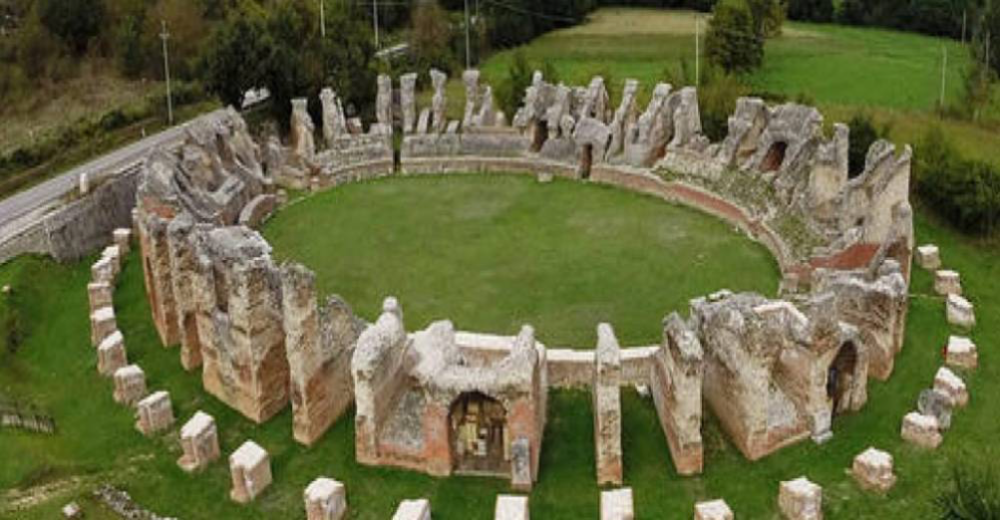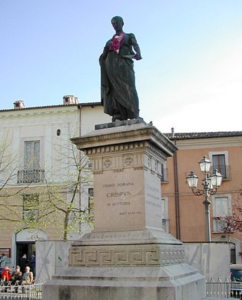AMITERNUM and SALLUSTIO
The Upper Aterno Valley has always been a fertile and favourable area for human settlement, so much so that the Sabine population settled there, building the small village of Amiternum, whose name probably derives from the Aterno river (Aternum) that ran through it.
According to Marco Porcio Catone, the Sabines originated from a village near Amiternum (Testruna).
With the Roman conquest (Samnite Wars – 293 B.C.), Amiternum soon became an important city (tens of thousands of in habitants) due to its position at the centre of a road junction of the ancient Via Cecilia, Via Claudia Nova and two branches of the Salaria and its flourishing sheep farming.
The city’s greatest development occurred in the Imperial Age, (27 b.C. proclamation of Octavian as ‘Augustus’ and 476 a.D.) when the most important buildings were erected.
For at least four centuries, Amiternum played the role of centre of power, continuing to develop in a marked way, and the exponents of the most important families of Rome resided there, while the ordinary citizens lived, in all probability, in the surrounding hills, the so-called Ville di Preturo.
In the 3rd century the town was still an Episcopal seat, but already in the following century it lost this honour.
In 346-47 the town was hit by an earthquake, but that probably did not cause any damage as the epicentre was quite far from the town and by the 4th century it was probably devastated by the Gothic wars like the rest of Italy.
Several important figures in Roman history were born in Amiternum; the earliest known is the consul Appio Claudio Cieco, an important figure in the period of Rome’s wars against the Samnites and remembered above all for having initiated the construction of the Appian Way in 312 b.C.
In 86 b.C. the historian Sallustio was born in the city, and about a century later Ponzio Pilato, the future prefect of Judea, was born here, known for having tried and condemned Jesus Christ, and later sentenced to death by Tiberius. The surrounding region is also said to have been linked to the last part of Pilate’s life. According to some legends, the procurator’s body was left unburied in the vicinity of Lake Pilato as a further punishment. It also seems that he owned a villa in the place now called Pilato’s mountain, near L’Aquila, near Fontecchio.
Although it survived the fall of the Western Roman Empire, Amiternum experienced a period of great decadence until it disappeared completely in the 13th century.

There are several well-preserved remains of Aminternum, located in San Vittorino.
The most interesting are:
- amphitheatre from the 1st century A.D. that could hold up to 6,000 people, whose two floors are in good condition;
- theatre from the Augustan age with a diameter of 80 metres and seats for 2,000 people;
- villa from the late imperial age, with mosaics and frescoes;
- remains of baths and an aqueduct also dating from the Augustan age;
- Various epigraphs and sculptural and architectural material have been preserved in the area.
Other important testimonies, including a Roman villa, have recently been found in the surrounding area near Coppito and Pizzoli.
Gaio Sallustio Crispo (Gaius Sallustius Crispus – Amiternum, 01/10/86 BC – Rome, 13/05/34 BC), more simply known as Sallustio, was a Roman historian and politician in the Republican era.
He came from a plebeian family linked to the municipal nobilitas and became first quaestor, then tribune of the plebs and finally senator of the res publica.
After being expelled from the Senate for moral unworthiness, he took part in the civil war of 49 BC between Caesar and Pompey, siding with Caesar. After Pompey’s defeat, Caesar rewarded him for his loyalty by giving him the praetorship, readmitting him to the Senate and appointing him governor of the province of Africa Nova.
After Caesar’s death, he retired from political life and devoted himself to the writing of historical works, in particular the two monographs “De Catilinae coniuratione” and “Bellum Iugurthinum”, the first of Latin historigraphy and the “Historiae”, a work of annalistic type.
Thanks to these important works he achieved enormous fame and is counted among the most important Latin historians of the first century b.C. and of the whole of Latinitas.

(from whikipedia and other sources)

